Featured Comment
Superb! I doubled the recipe and made it for guests. The process of crisping up the chicken is well worth it and the ponzu sauce was brilliant.
★★★★★
– Brittany (from Pinterest)
There’s more to Japanese chicken than teriyaki or karaage. Imagine juicy chicken crackling in the pan, then soaked in bright, citrusy ponzu that wakes up your whole kitchen.
If you love a sharp, refreshing tang, this ponzu-glazed chicken is really for you.
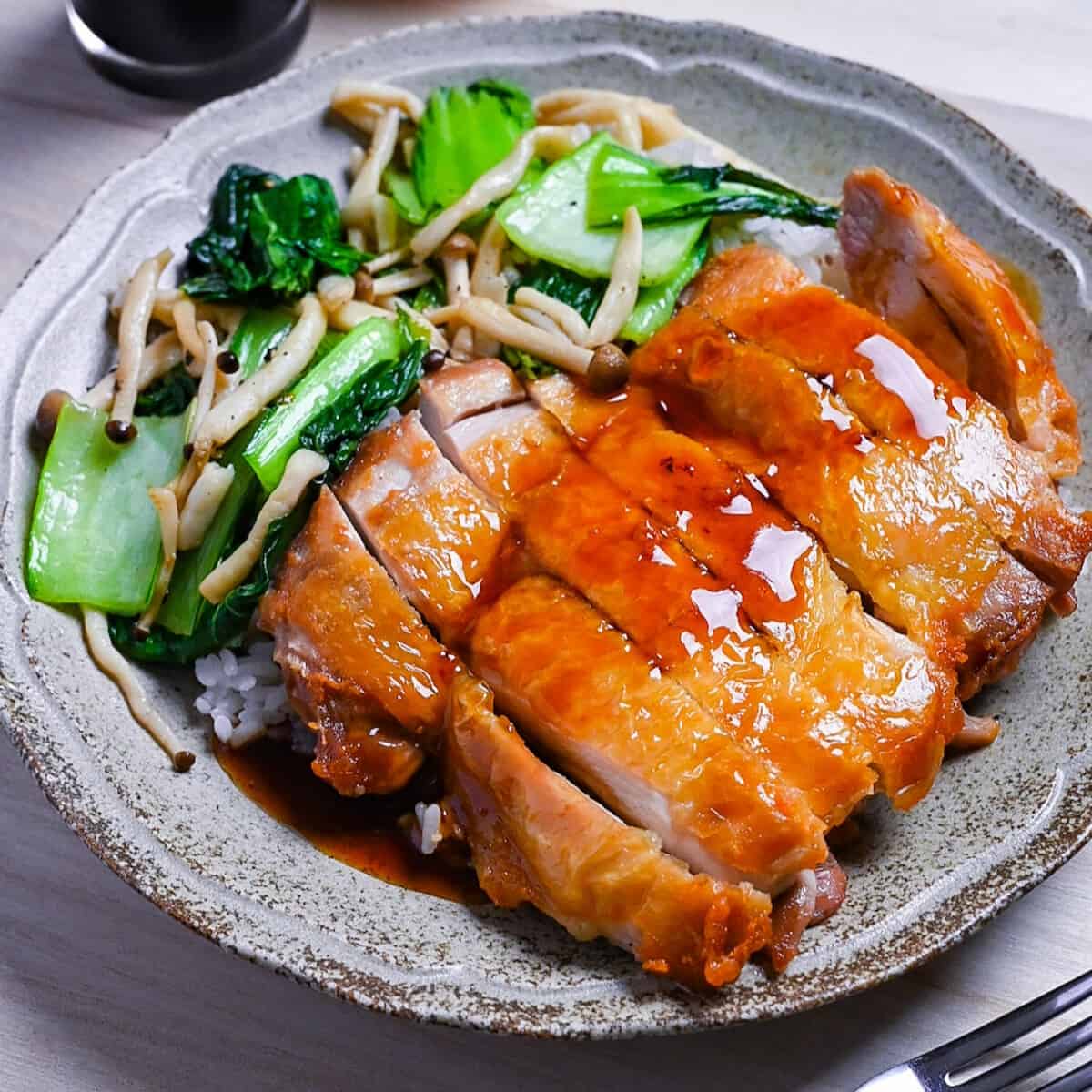
Ponzu Chicken
Recipe Snapshot
- What is it? Crispy-skinned chicken glazed with bright, tangy ponzu sauce.
- Flavor profile: Citrusy, Savory, Tangy
- Why you’ll love this recipe: The recipe stays weeknight-friendly while still feeling special enough for guests, which helps bridge the gap between everyday cooking and “impress them” cooking.
- Must-haves: Ponzu Sauce (Store-bought or homemade), Skin-On Chicken (Preferably Thighs), Heavy-Bottomed Pan
- Skill Level: Easy
Summarize & Save this content on:
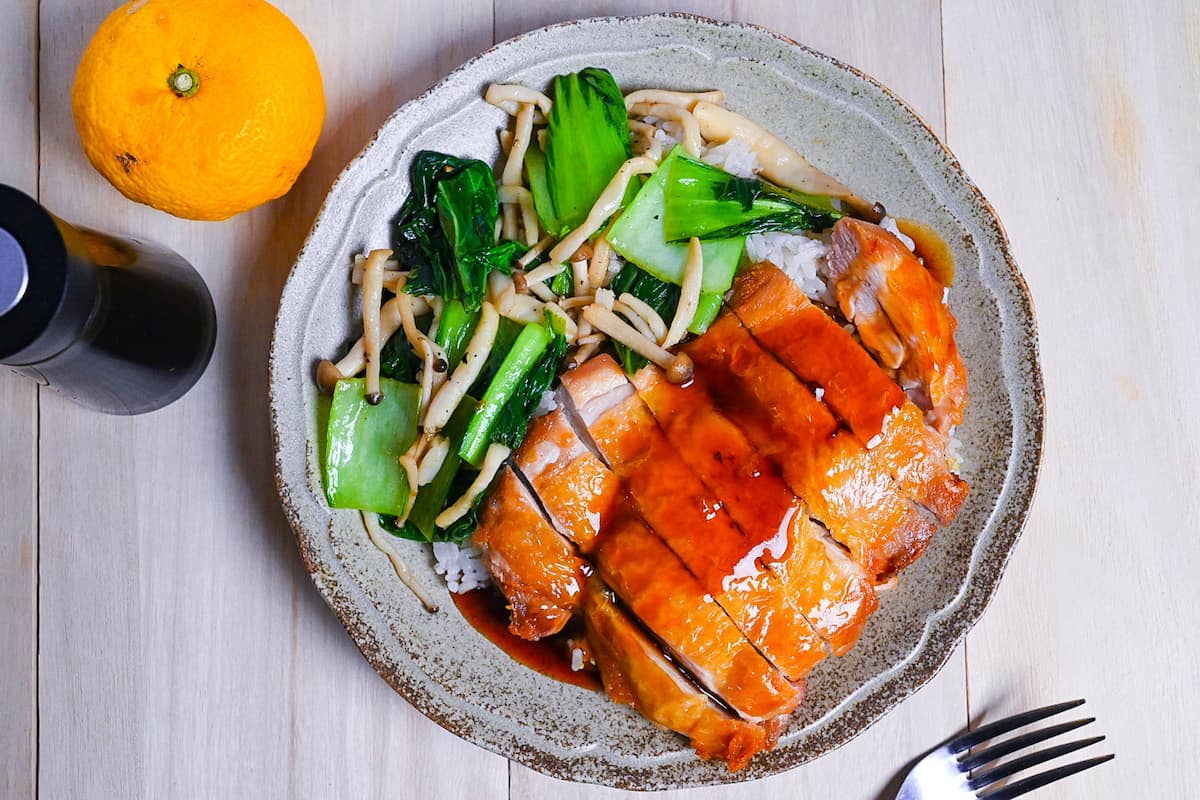
What is Ponzu Chicken?
Ponzu chicken is essentially any dish that combines chicken with Japanese ponzu sauce, whether it be stir-fried, marinated, or glazed, they are all variations of “ponzu chicken”. For my ponzu chicken, I pan-fry chicken thighs until the skin is extremely crispy and then drizzle it with a glossy homemade ponzu glaze.
This dish is a little similar to teriyaki chicken, but with a bold and citrusy kick from the ponzu sauce. If you’re like me and love sour flavors, you’re definitely going to love this dish!
I serve my ponzu chicken with white rice and sautéed pak choi and shimeji mushrooms, but feel free to serve it with any of your favorite stir-fried vegetables!
Ponzu Chicken Ingredients

- Boneless Chicken Thighs: Choose boneless, skin-on chicken thighs. The skin renders into golden, crackly edges that baste the juicy dark meat and make this dish pop. If your store doesn’t carry them prepacked, the butcher can quickly remove the bone while keeping the skin attached. Skin-on chicken breast can be an alternative, but not gonna be as juicy.
- Cooked Japanese Short-Grain Rice: Japanese short-grain rice cooks (Calrose is a good sub) up glossy, plump, and slightly sticky so every bite carries sauce. You can grab it at Asian groceries.
- Ponzu Sauce: Ponzu (citrus-soy sauce) is a bright, tangy blend of soy, citrus like yuzu or lemon, and a touch of vinegar. You can buy it at Asian groceries or mainstream chains.
Substitution Ideas
- Bok choi: Any of your favorite stir fry vegetables.
- Shimeji mushrooms: Your favorite type of mushroom.
- Potato starch: Cornstarch of tapioca starch.
Have trouble finding Japanese ingredients? Check out my ultimate guide to Japanese ingredient substitutes!
How to Make My Ponzu Chicken
If you prefer to watch the process in action, check out my YouTube video of this ponzu chicken recipe!
Before you start: Set each boneless, skin-on chicken thigh skin-side down and snip through the thickest seams of meat with kitchen scissors, then press to an even thickness. Flattening evens heat exposure so the meat cooks quickly and uniformly without overcooking the thin edges.
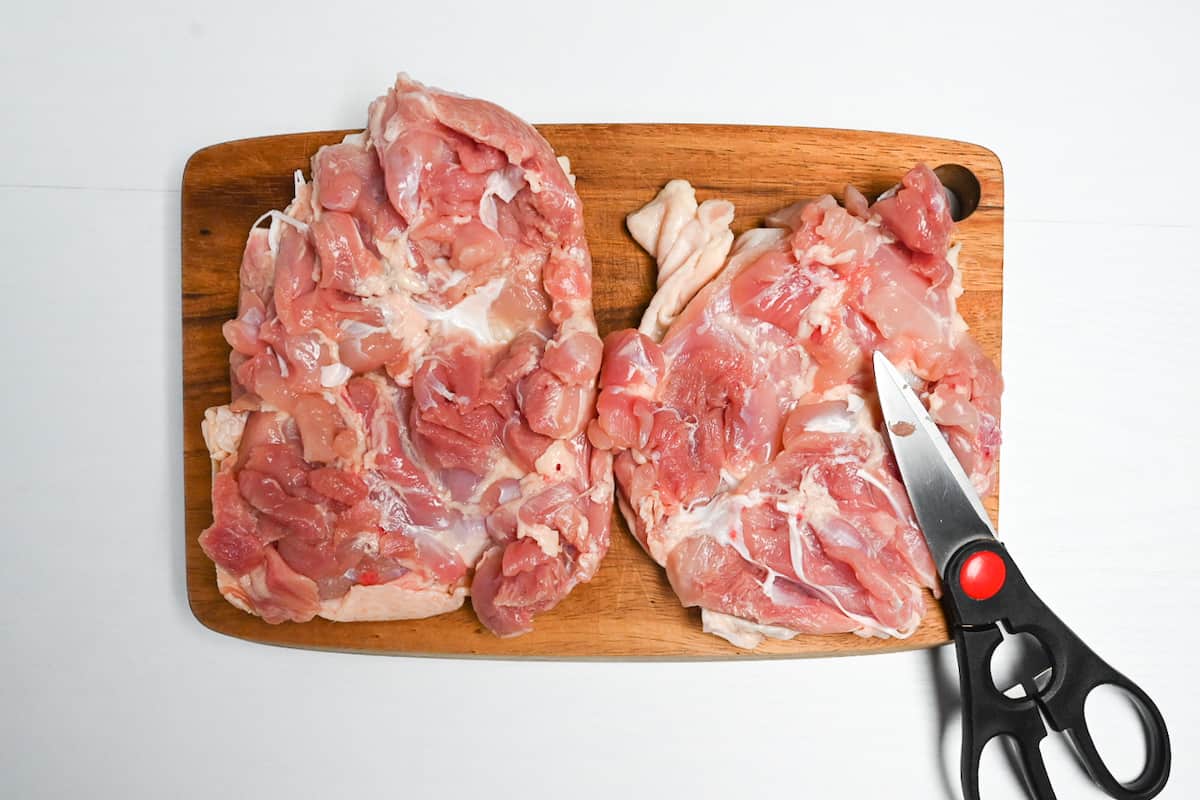
i. Pull the skin so it fully covers the surface.
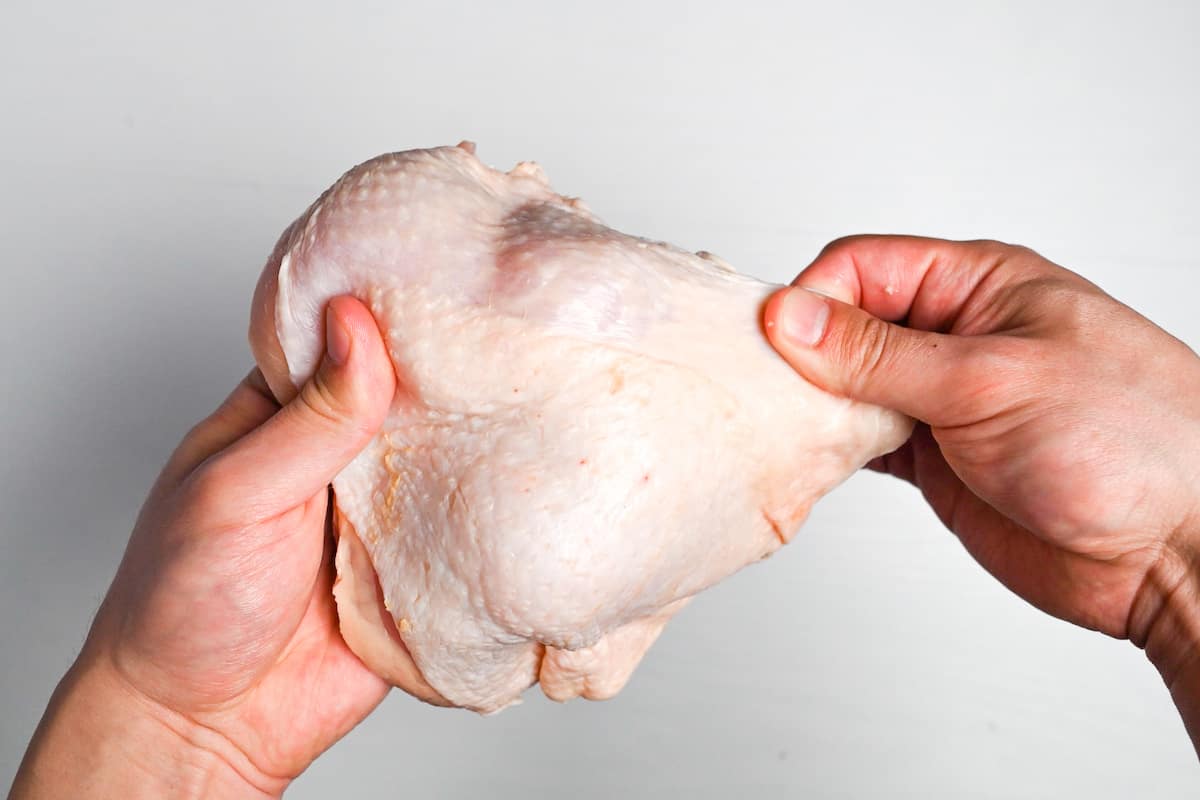
ii. Then place the thighs skin-side up on a rack set over a container, meat side protected with plastic wrap. Pat the skin dry and refrigerate uncovered for 30 minutes.
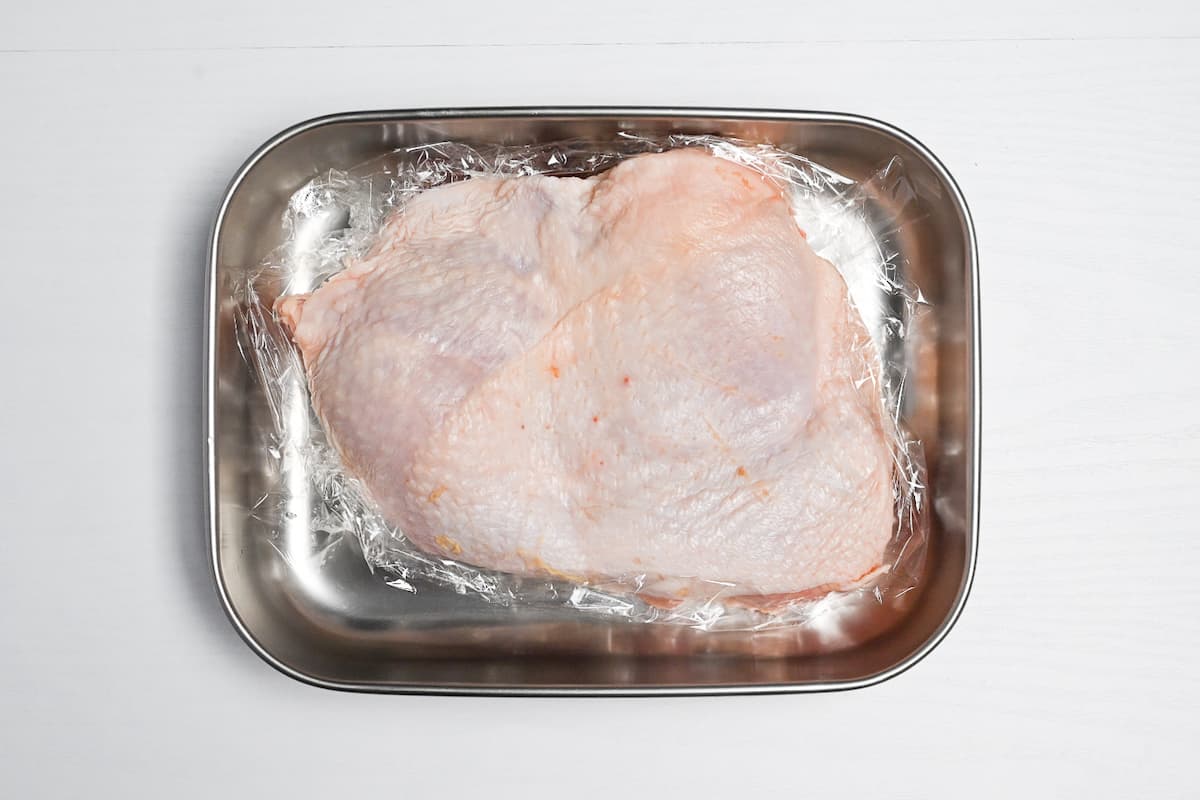
This air-chill draws moisture from the skin’s surface while the plastic wrap underneath keeps the meat itself juicy and tender. It’s optional, but if you love the extra crispy skin like me, it won’t disappoint you!
Make sure to store raw chicken below other foods and avoid potential drips or contact with produce!
i. Choose a wide pan so both thighs can lie perfectly flat. Add a thin film of neutral oil to the cold pan, lay the thighs in skin-side down, and season the exposed meat with salt and pepper.
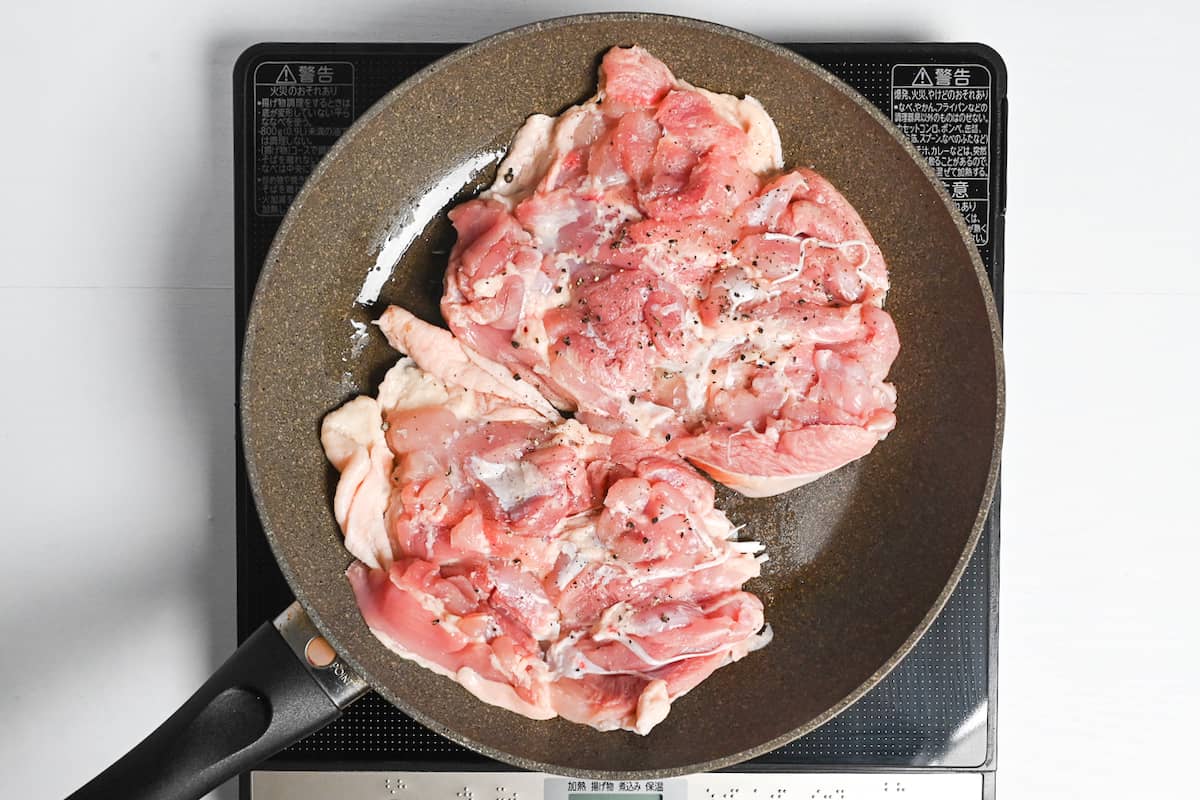
ii. Turn the heat to medium-low and let a gentle sizzle build. Slow heat gives the fat time to render and the skin time to crisp.
Cold-start searing renders fat gradually, yielding juicier meat and ultra-crisp skin without scorching, especially effective for skin-on thighs. I used to preheat the skillet hot, but repeated side-by-side tests gave blotchy skin and under-rendered fat. The cold-start delivered more evenly golden, glassy skin every time.
i. Cover the chicken with a piece of foil.
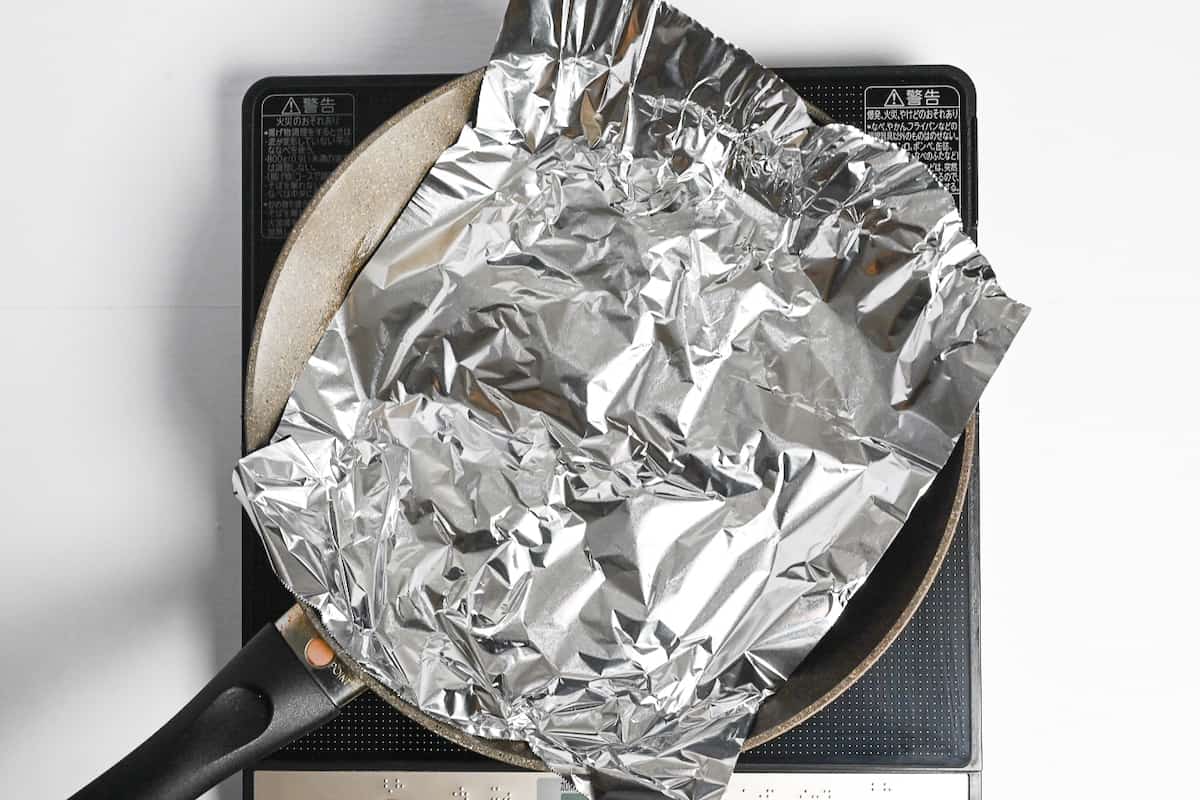
ii. Then place a small pot filled with water directly on top to press the skin into full contact with the pan. Keep the heat at medium-low until you hear a steady, modest sizzle and see fat pooling around the edges.
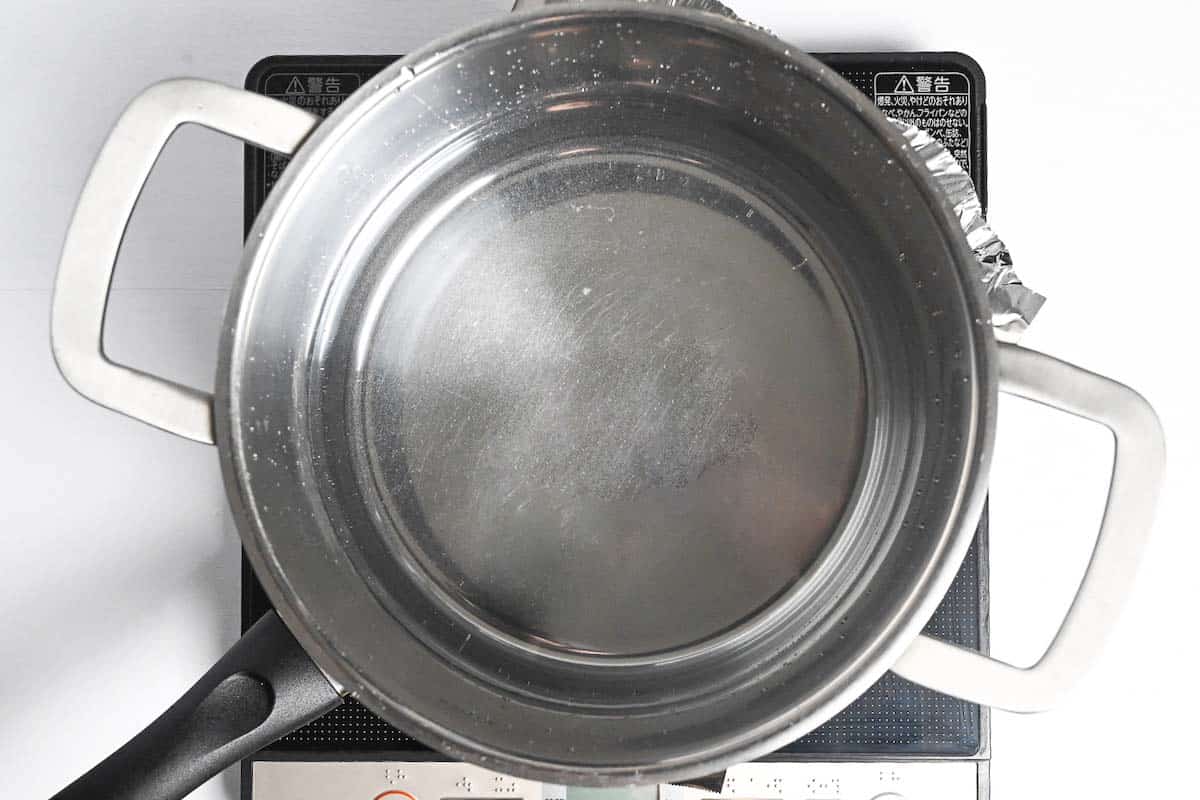
iii. Within a minute or two, you’ll hear a sizzle. That’s your cue to set a 10-minute timer and let physics do the work.
Chicken skin naturally curls as it cooks, pulling away from the pan and creating air gaps where no browning happens. By pressing a weight on top, you force every millimeter of skin into intimate contact with the hot oil. The pressure also flattens any remaining thick spots, ensuring the meat cooks evenly while the skin crisps uniformly.
You’ll end up with a thigh that’s golden from edge to edge, not just in random patches. After trying this method with and without the weight a dozen times during testing, the difference is night-and-day. I won’t skip it anymore.
i. When your timer chimes at the 10-minute mark, carefully lift off the pot and peel back the foil. Tilt your pan slightly and use a spoon to scoop up the shimmering, chicken-fat-enriched oil pooling at the edge. Drizzle this liquid gold over the top of each thigh repeatedly for 2 to 3 minutes.
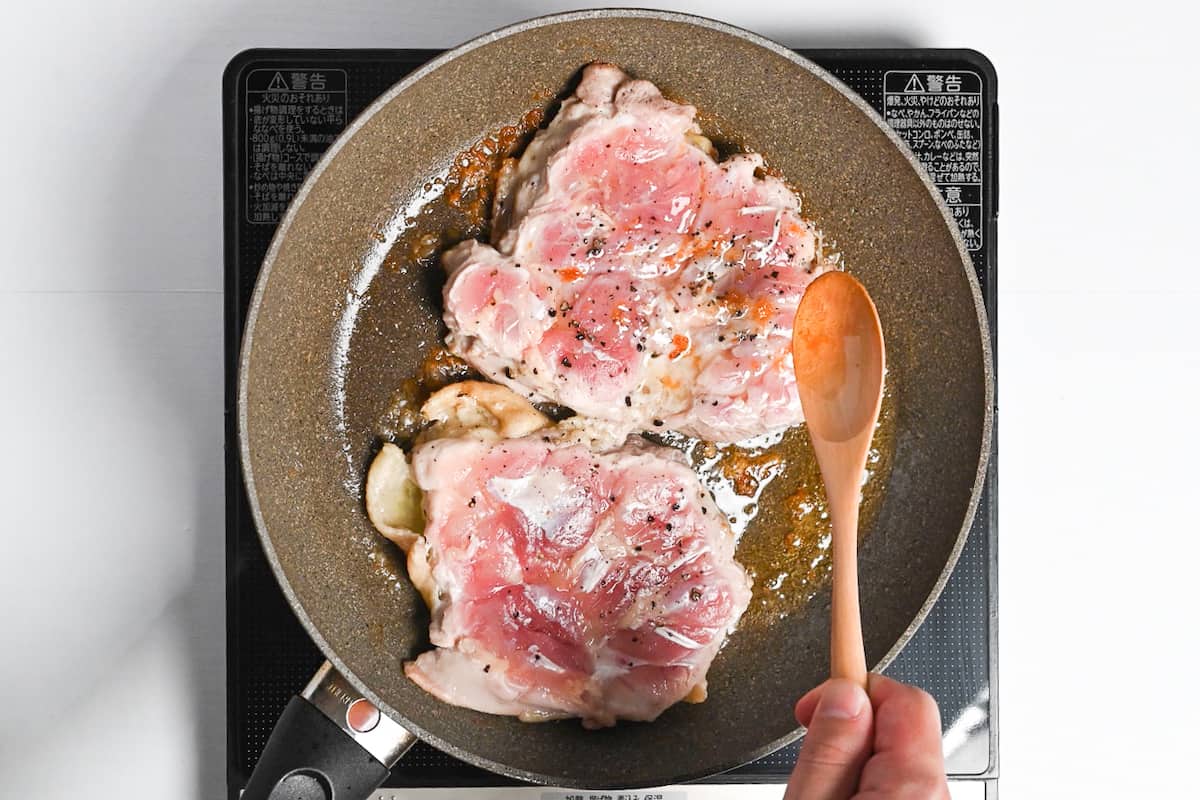
You’ll notice the surface start to glisten and tighten. That’s the meat fibers firming up and absorbing all those rendered flavors.
Of course, the top side of your chicken hasn’t touched the pan, so it needs help cooking through. Basting continuously bathes the meat in hot fat, gently raising its internal temperature while adding an extra layer of flavor.
i. Flip the thighs and cook the flesh side for 2-4 minutes, or until an instant-read thermometer inserted in the thickest part reads 74℃ (165°F). The juices should run clear, and the meat should feel springy, not squishy. Remove to a board.
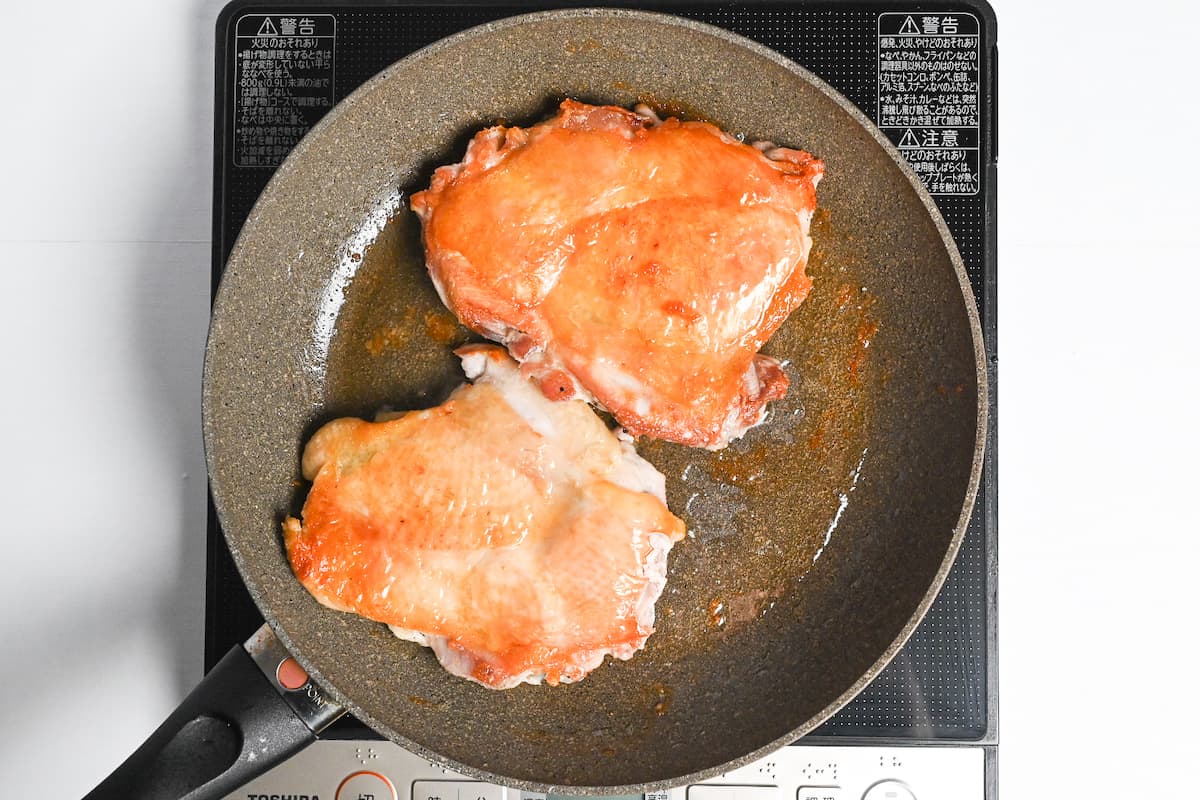
ii. Let the thighs rest skin-side up for 5 minutes while you cook the vegetables. Resting allows juices to redistribute for a cleaner slice and keeps the skin crisp if left exposed to air. If the board gathers juices, save them for the sauce.
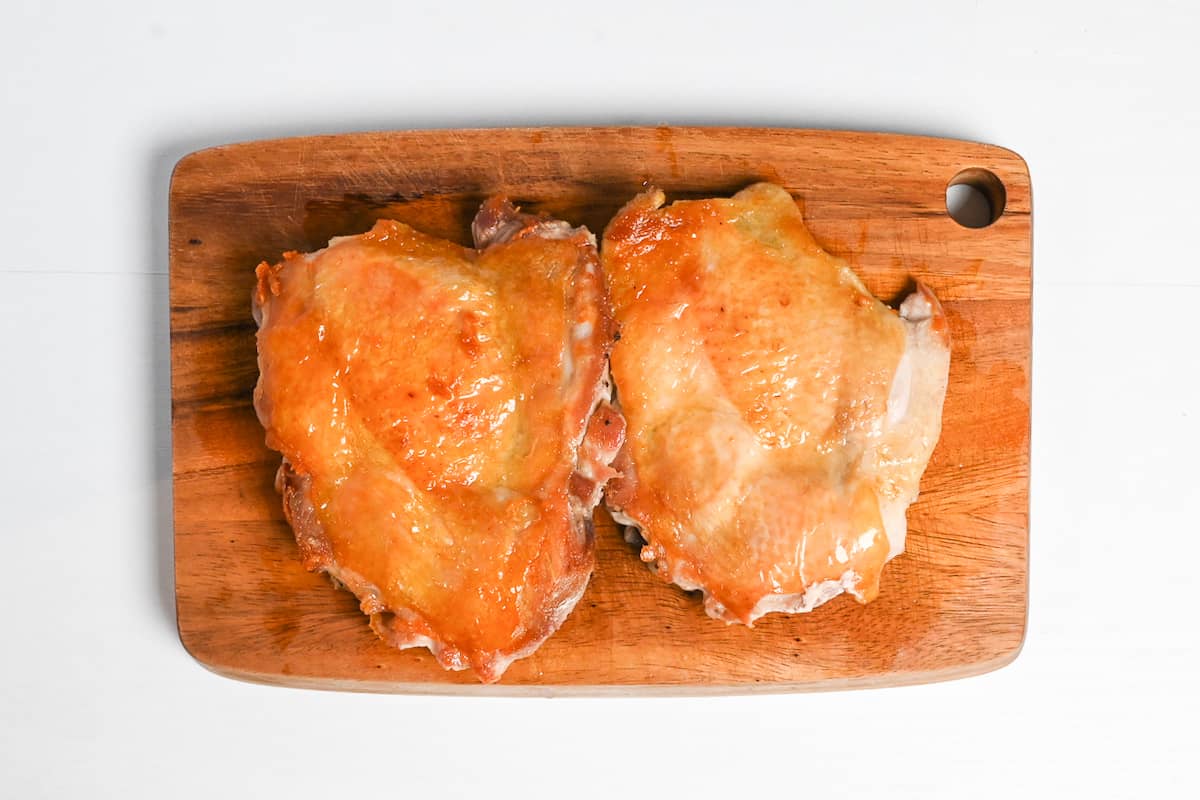
i. Return the same pan to medium heat and spoon off excess fat if needed, leaving about 1-2 teaspoons. Add your vegetables and a pinch of salt and pepper. Sauté until just tender and glossy, 2-4 minutes, so they absorb the savory schmaltz. If the pan feels too greasy, quickly blot with a paper towel and continue.
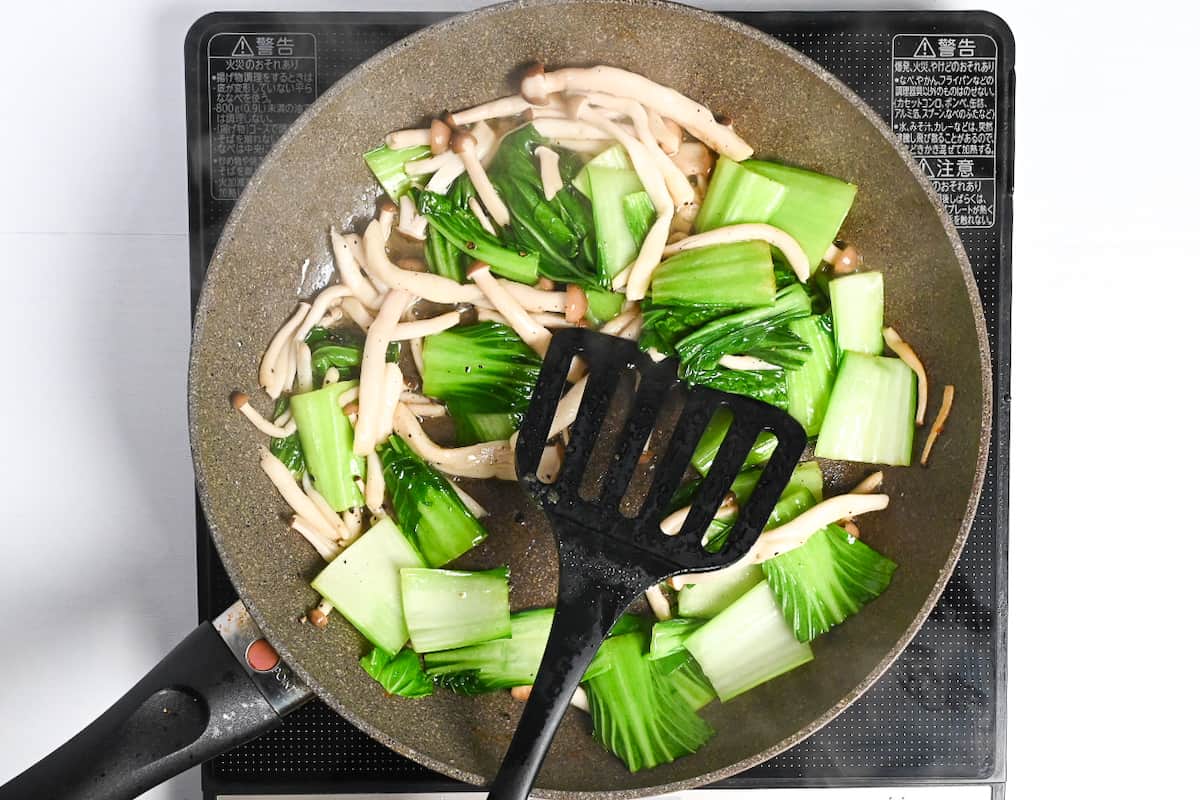
Cooking vegetables in the rendered fat captures the fond and aromatics from the chicken, giving you a head start on flavor without extra ingredients.
i. In a small saucepan, combine ponzu, mirin, sake, light brown sugar, and honey. Bring to a gentle simmer, around 85-95℃ (185-203°F), over medium heat and let it bubble for 1-2 minutes to dissolve sugar and cook off alcohol.
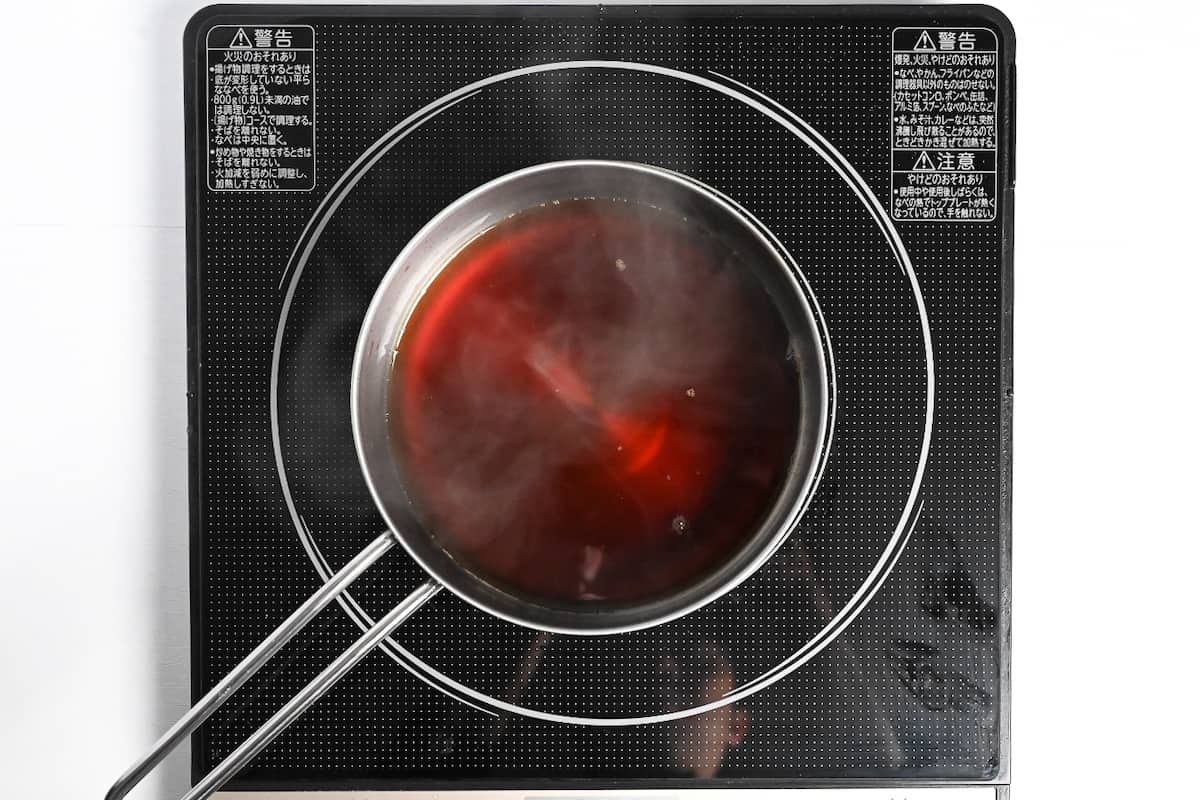
ii. Stir potato starch (or cornstarch) with cold water to make a smooth slurry. Reduce the heat to low, whisk the slurry into the simmering sauce, and stir just until it turns glossy and lightly coats a spoon.
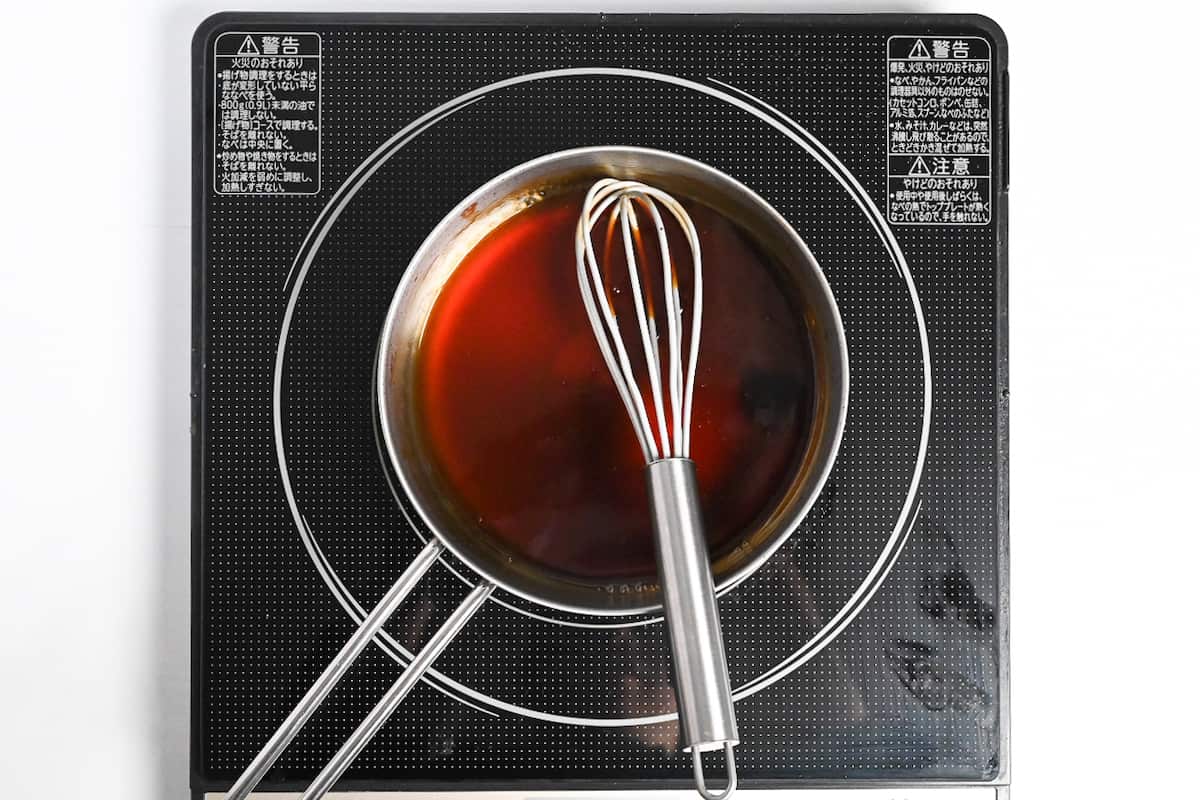
iii. Taste test: For brighter tang add a bit more ponzu, for sweeter balance add honey, if too intense, whisk in water. Keep the sauce below a hard boil to preserve its sheen.
i. Slice the rested chicken into thick strips, keeping the skin intact. Mound rice on each plate, layer on the chicken and vegetables.

ii. Then spoon the warm ponzu glaze over the top so it clings in a light, shiny coat. Serve immediately to enjoy the crackle of the skin at its best.


Essential Tips & Tricks
- Flatten each thigh to an even thickness first.
- Start the chicken in a cold pan with oil and bring the heat up to medium-low.
- Use a weight (small pot of water over foil) so the thighs stay flat and every bit of skin touches the pan.
- After removing the weight, baste the top of the chicken with the rendered fat.
- Let the chicken rest skin-side up so the juices redistribute and the skin stays crisp.
With these simple tips in mind, you’re set for success every time you make ponzu chicken.
What to Serve With This Recipe
Ponzu Chicken FAQ
Ponzu sauce is a Japanese citrus-soy condiment made from soy sauce, vinegar, and citrus like yuzu, lemon, or kabosu. It delivers salty, tangy, lightly sweet flavor and pairs especially well with fatty meats or fried foods. The name comes from the Dutch word pons (citrus drink) combined with zu (vinegar) in Japanese.
Boneless, skin-on thighs are ideal because they lie flat and crisp evenly. Bone-in thighs take much longer and won’t crisp uniformly, and skinless cuts lose the key textural contrast. Breast meat is possible but not recommended. Its lower fat content makes it prone to drying during the slow, cold-start crisping process.
You can use any small, heat-safe object that fits inside the pan. A smaller skillet, a plate with a can of food on top, or a metal lid. Just create gentle, even pressure. Avoid anything plastic or glass that could melt, warp or crack.

More Quick Japanese Recipes
- Sukiya Gyudon (Japanese Beef Bowl)
- Quick & Easy Yakiniku Don (Japanese BBQ Style Beef Bowl)
- Niku Yasai Itame (Japanese Vegetable Stir Fry with Pork)
- Okinawa Taco Rice And Cheese (Cafe Style)
Need dinner on the table fast? Browse my go-to collection of under 30 minutes Japanese recipes!
Did You Try This Recipe?
I would love to hear your thoughts!
💬 Leave a review and ⭐️ rating in the comments below. 📷 I also love to see your photos – submit them here!
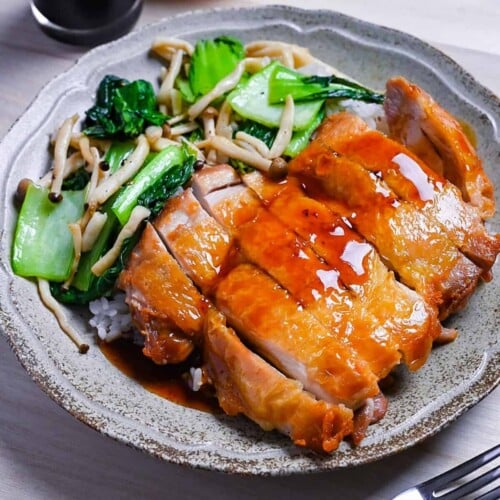
Easy and Delicious Ponzu Chicken
Ingredients
- 500-600 g boneless chicken thigh boneless, skin-on
- 2 pinches salt and pepper
- 2 tbsp cooking oil neutral
- 200 g bok choy (pak choy) or other stir-fry vegetables
- 150 g mushroom of your choice shimeji or similar
- 2 portions cooked Japanese short-grain rice or Calrose
Ponzu Chicken Sauce
- 90 ml ponzu sauce store-bought or homemade
- 2 tbsp mirin
- 2 tbsp sake drinking sake recommended
- 2 tsp light brown sugar or white sugar
- 1 tsp honey
- 1 tbsp cold water to make slurry
- 1 tsp potato starch (katakuriko) to make slurry
My recommended brands of ingredients and seasonings can be found in my Japanese pantry guide.
Can’t find certain Japanese ingredients? See my substitution guide here.
Instructions
- Lay 500-600 g boneless chicken thigh out on a chopping board with the skin side facing down, and use kitchen scissors to make incisions in the thickest parts of the meat. These incisions will make flaps, pull them outwards to flatten the chicken. (You can also use the scissors to cut out any sinew or tendons.)

- Turn the chicken over and stretch the skin so it is wrapped over the edges.

- Cover the flesh side with plastic wrap and place the chicken in a container with the skin side facing up. Pat the surface of the skin dry with kitchen paper and store the chicken in the fridge uncovered for about 30 minutes to dry it out. (Make sure the chicken isn't touching any other items in your fridge to avoid cross contamination.)

- Take a large pan and add 2 tbsp cooking oil while it's still cold. Swirl it around to coat the bottom. Place the chicken in the cold pan with the skin side down and sprinkle with 2 pinches salt and pepper.

- Place a piece of foil over the top.

- Take a pot that is small enough to fit in the frying pan, fill it half way up with water and place it on top of the foil. This will act as a weight and help the chicken skin become extra crispy. Place the pan on the stove and set the heat to medium-low. Once you start to hear sizzling, set a timer for 10 minutes.

- After 10 minutes have passed, remove the pot of water and foil. Baste the top of the chicken with oil from the pan for 2-3 minutes.

- Flip the chicken over and fry on the other side for 1-2 minutes.

- Transfer the chicken to a chopping board and leave to rest until serving time.

- In the same pan, sauté the 200 g bok choy (pak choy) and 150 g mushroom of your choice in the chicken juices for a few minutes with a pinch of salt and pepper. (If you feel the pan is too oily, wipe it with kitchen paper first.) Once cooked, remove from the heat.

- Take a small saucepan and add the 90 ml ponzu sauce, 2 tbsp mirin, 2 tbsp sake, 2 tsp light brown sugar and 1 tsp honey. Mix well and bring to a boil over a medium heat. Allow it to bubble for 1-2 minutes.

- Reduce the heat to low and mix 1 tbsp cold water and 1 tsp potato starch (katakuriko) in a small bowl to make a slurry. Pour the slurry into the ponzu sauce and mix. Simmer until thickened slightly and then remove from the heat.

- Cut the chicken into strips and plate up with 2 portions cooked Japanese short-grain rice and vegetables.

- Drizzle the ponzu sauce over the chicken and vegetables, and enjoy!

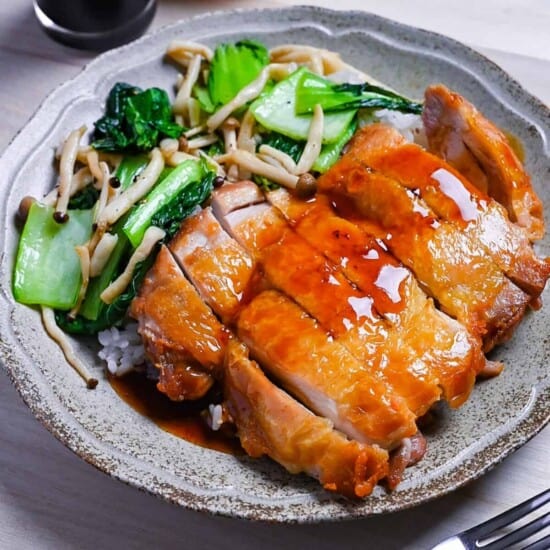





Could you use chicken breasts rather than thighs?
Hi Karen,
Thank you for your question.
I have only made this recipe with chicken thigh, but in theory, chicken breast works just fine as long as it’s skin-on breast.
I hope this answer helps!
Yuto